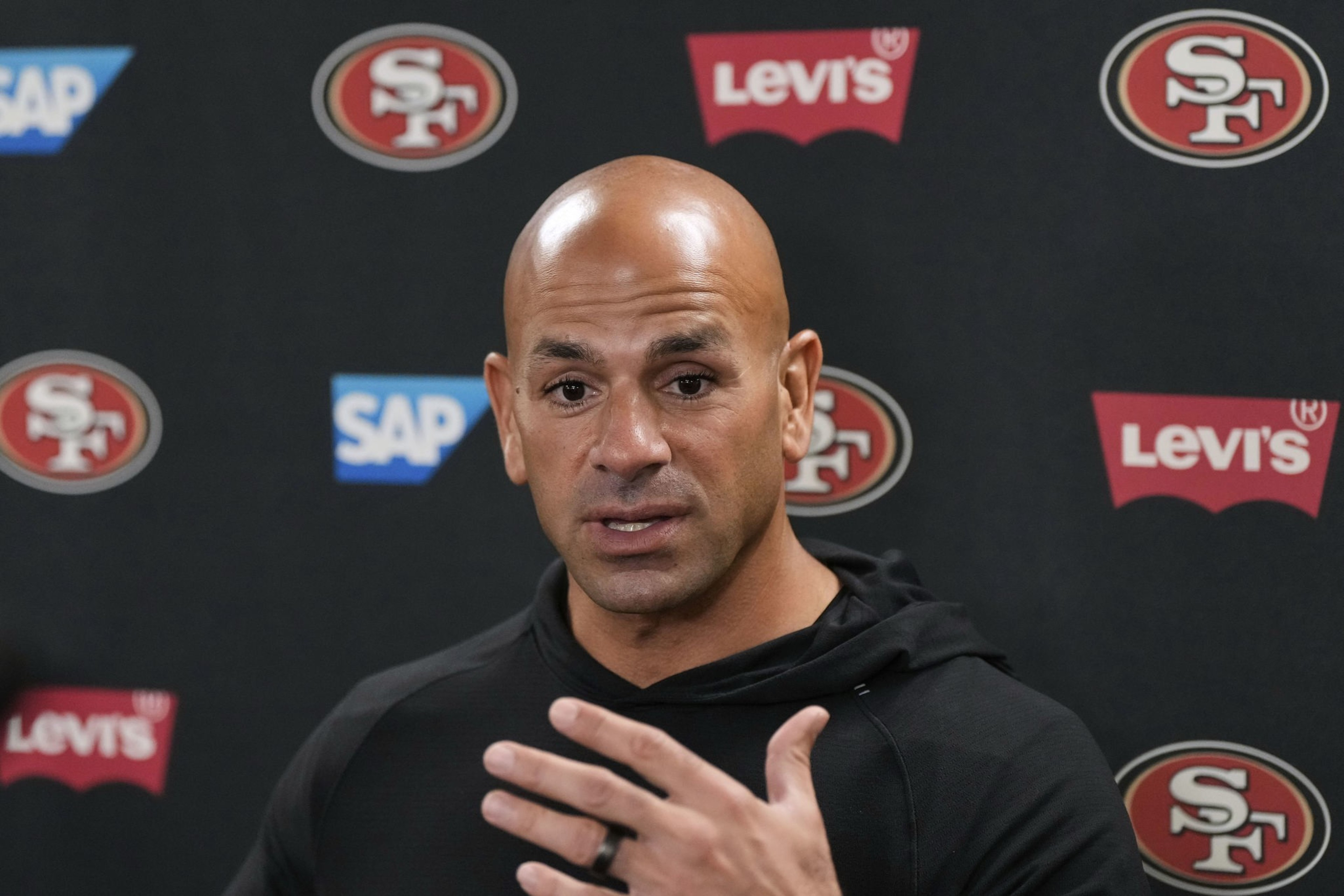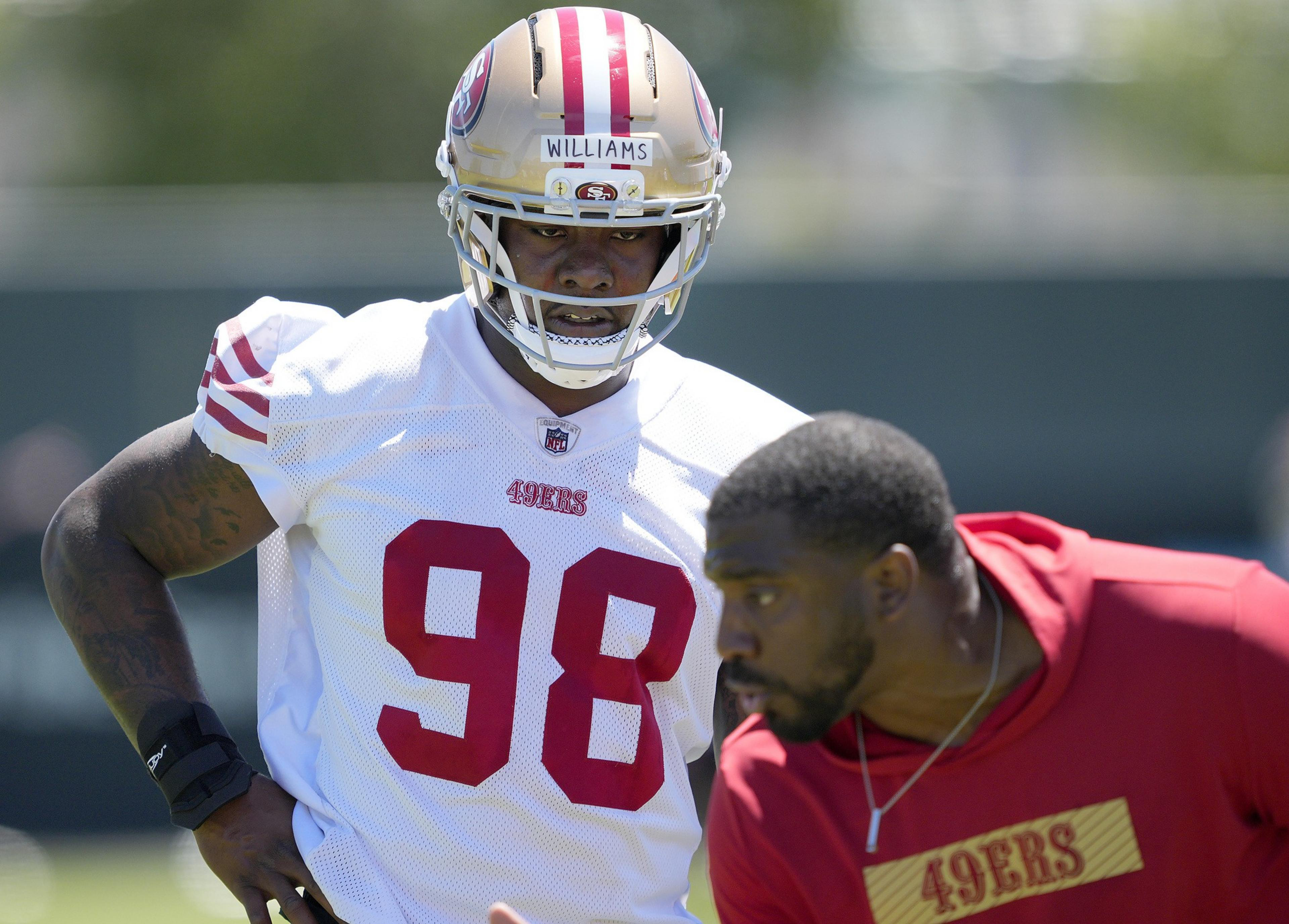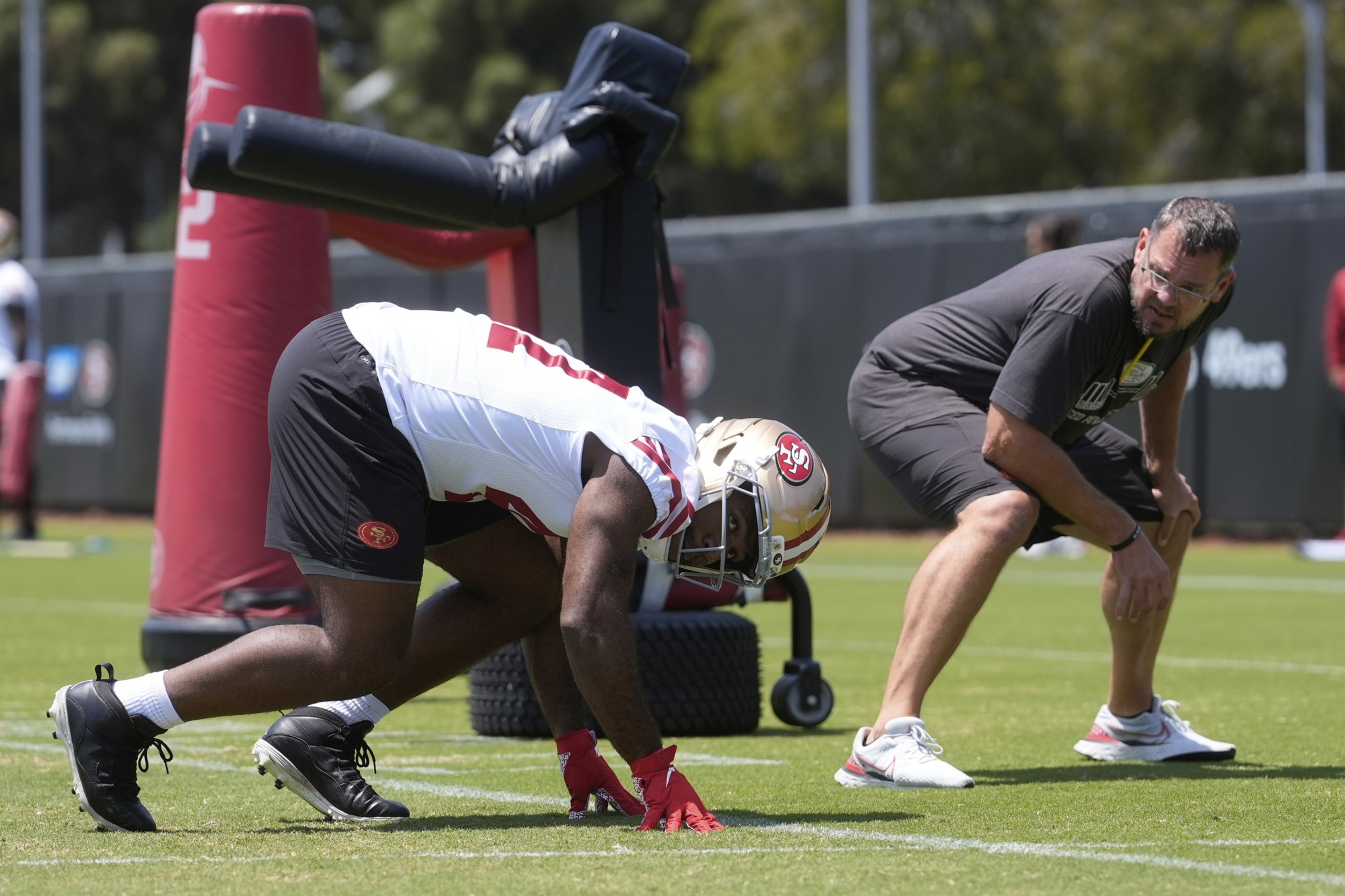Want the latest Bay Area sports news delivered to your inbox? Sign up here to receive regular email newsletters, including “The Dime.”
When Robert Saleh and Kris Kocurek last joined forces, the 49ers defense enjoyed a seismic resurgence.
The year was 2019. Saleh had laid a workable foundation as the 49ers’ defensive coordinator for two seasons at that point, but he didn’t have the level of personnel — especially when it came to edge-rushing talent — to field a good defense. The 49ers ranked No. 26 in expected points added (EPA) per play.
So the 49ers made a massive investment in their defensive line that offseason. They drafted Nick Bosa with the second overall pick. They traded for and signed fellow defensive end Dee Ford to a big contract. And they brought in Kocurek to coach the defensive line and radically change its playing style.
Compared with the languishing 2018 version, the 2019 49ers defense was unrecognizable. Kocurek’s new Wide 9 approach, designed to give edge rushers advantageous pass-rushing angles against offensive tackles, produced 48 sacks and a huge uptick in takeaways. The 49ers defense finished ranked No. 2 in EPA per play. And in the seasons that followed, even after Saleh left to coach the New York Jets in 2021, Kocurek’s defensive lines continued producing.
But over time, defensive line investment slowed considerably. The 49ers didn’t spend a single first-round pick on an edge rusher between their 2019 selection of Bosa and their drafting of Georgia’s Mykel Williams earlier this year. The biggest exterior D-line expenditure came in 2022 for Drake Jackson, whom the 49ers nabbed at the end of the second round (No. 61) and waived with a failed physical designation about two months ago.
That contextualizes the performance erosion of the past two years, which has seen the 49ers tumble toward the league cellar in run defense while losing pass-rushing steam. And while much blame has fallen at the feet of Steve Wilks and Nick Sorensen, consecutive 49ers defensive coordinators who both lasted in that role for only one year, it also became blatantly obvious in 2024 that Kocurek was working with less D-line firepower than at any point since 2018.
So the 49ers hit the big, red reset button this offseason. And it all began with a re-creation of what led off the 2019 makeover: a pairing of Saleh with Kocurek.
There’s an inversion this time, of course. Saleh, not Kocurek, is the newcomer. But that’s inconsequential. What matters to the 49ers is that their preferred coordinator and preferred line coach are back together, and there’s a strong belief that this combination — plus the large-scale infusion of fresh blood via the NFL Draft and trade for edge rusher Bryce Huff — can shepherd the line back to success.
“You’re going to see some changes on the back end — more there than up-front,” Kocurek said last month of Saleh, who (like all NFL coaches) has evolved areas of his approach over the years. “But it’s still Robert Saleh’s defense. And up-front, there will only be small, minute tweaks.”

That’s a key note. It verifies that the 49ers maintain full belief in Kocurek and his Wide 9 approach as new faces establish themselves around Bosa, who’s entering his seventh season as the line’s centerpiece.
The 49ers project to have three new starters and four new primary D-line rotation pieces, a massive undertaking for any team — especially one that fancies itself as a contender and not a rebuilder. And the 49ers have chosen to approach this ambitious venture with the same philosophy that worked in 2019.
Kocurek’s defensive line will be the bedrock of Saleh’s evolving front seven, and the only way that can successfully re-blossom is if the 49ers rely on the leadership that’s been around since the initial meeting of minds back in 2019.
“It’s instrumental that Nick Bosa and Kevin Givens set the tone,” Kocurek said. “And even the guys who have been here a year and know how things are run here, they need to articulate that to the younger guys. I think it’s very, very important.”
Kocurek noticed initial stages of that trickle-down effect over the spring, after Williams and fellow draftees Alfred Collins and C.J. West first reported to the 49ers building.
“If you watch at practice, Mykel is always standing right behind Nick,” Kocurek said. “He’s a kid who’s really willing to learn and always wants to know why. He has an eagerness to learn and correct mistakes very quickly and pull information from Nick. And Nick has a willingness to teach him intricate details on the field.”
And while Givens is a far less prominent player than Bosa, he has averaged 349 snaps per season for the 49ers over the past half-decade and is the team’s one long-term bridge to the past at defensive tackle — a position once manned by stalwarts DeForest Buckner, D.J. Jones, and Arik Armstead.
The 49ers are hoping that Collins, West, and Williams are able to reprise a good chunk of that trio’s production within Kocurek’s system. The value of Givens’ institutional knowledge, therefore, should not be underestimated.
The most significant binding tie between what the 49ers accomplished in their peak D-line years and what they hope to re-create in 2025 and beyond lies in positional versatility up-front. Armstead spearheaded this starting in 2019 with his shuffling between base-down end and pass-rushing tackle, but he was only one of many Kocurek linemen who found comparative advantages strategically operating from multiple spots.

The 49ers hope that Williams, whose college position was called the “Jack” because of its adaptability, can ultimately emulate large swaths of Armstead’s game.
“It’d be a steeper learning curve if he’d played primarily an edge position in college and had rarely moved inside, but watching Mykel play at Georgia, he was a Swiss Army knife — saw him all the way from the 9-technique to the A-gap and excelling at all of them,” Kocurek said. “Based on that, the learning curve won’t be quite as steep. Seeing him multi-align on college tape was big for us to know that we can utilize matchups over guards and also get after the passer and set the edge in the run game.”
In a related fashion, Kocurek will want to use West — who has a notably stout 6-foot-1, 316-pound frame — in a multipurpose role. Such adaptability made Jones particularly effective toward the end of his 49ers tenure and earned him a lucrative contract with the Denver Broncos.
“When we’re looking at [defensive tackles] in an evaluation setting, we kind of get a sense of, “Hey, is this guy more of a 3-technique? Is this guy more of an A-gap player playing down as a 2i and a shade?’” Kocurek said. “But with the way offenses are nowadays and the way they can manipulate the fronts and make us slide the fronts, you have to have the versatility to play both.
“Some guys are more built for the A-gap, and the longer players are maybe a little better suited to play the 3-technique. But they’ve got to be able to play both. They’ve got to be interchangeable.”

Even Huff, whom the 49ers acquired for the specific purpose of rushing the passer (they don’t plan to play him in running situations), will be asked to show positional versatility under Kocurek. That’s just how this line has operated going back to that magical 2019 run, which even saw the 245-pound Dee Ford — in many ways the archetype for Huff in this system — kick inside for creative rushing situations.
“Bryce can also bump down as a spinner, stand-up dude,” Kocurek said. “That allows you to have more moving parts across your front. It allows you to locate matchup issues from a protection standpoint, a personnel standpoint.”
The vision is apparent. The 49ers, with both Saleh and Kocurek on board, believe they can combine the best of the past with the realities of the present — which features a high amount of D-line investment again.
It hadn’t been that way for a few years, and the 49ers certainly didn’t like the diminishing results up-front. So, what’s the early prognosis for 2025 with all these new ingredients?
“So far, so good,” Kocurek said near the end of the spring program. “But we won’t get the true assessment of it until we get the pads on and it gets going at the level that correlates to Sundays.”
That’s coming, as 49ers training camp is less than two weeks away.



